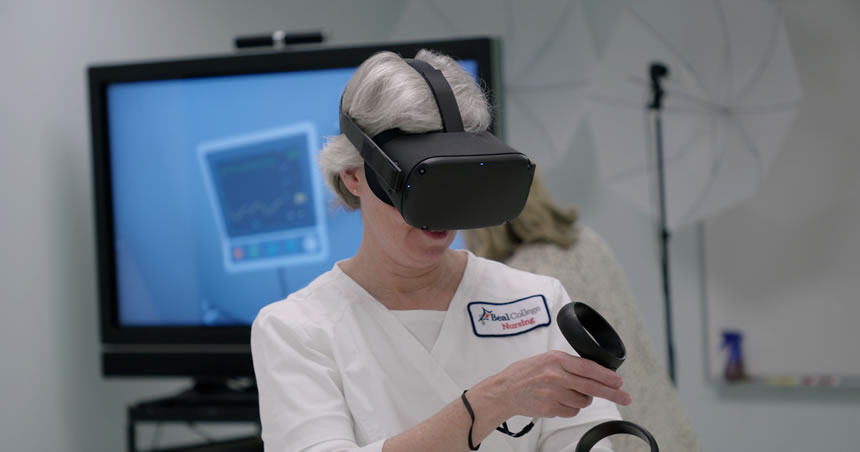Beal University ADN Students Develop Deeper Thinking with SLS with VR

Bangor Daily News | Nursing instructor Lorrie Springer gained her initial nursing education in the same way her students at Beal University do—in a two-year, ADN program. Knowing their background and having gone through the same experience led her to an important question: is it possible to provide the same experience to two-year students who take similar boards to four-year students?
“How can I, as an instructor, give them more of an experience in that simulation to get them there quicker, to help them critically think more, to help them think outside the box to help them immerse themselves in a situation where sometimes speaking with a mannequin isn’t the same?”
The answer? Immersive virtual reality (VR) technology delivered through Simulation Learning System (SLS) with VR that transformed how Beal University delivers simulated patient experiences. Lorrie says students have embraced VR as a new way of developing important skills to properly take care of patients and work in the healthcare setting.
The Move to VR
Lorrie was there at the very beginning of Beal University’s nursing sim program when they were just starting to bring manikins to the lab space. About half a year in, they were given the opportunity to try out SLS with VR alongside their students. When COVID impacted access to clinical settings, Lorrie says the timing of the pilot worked well with their need to pivot their courses. She said it was beneficial that SLS with VR allowed multiple students to be in the VR environment at once in addition to the convenience of an enhanced online simulation when they couldn’t be together in the classroom.
“When we decided to do the pilot, it was really [a question of] if we need to do more clinical through simulation, do we have the ability to do that. And that gave us another tool,” Lorrie says.
Learn more about SLS with VR
Beal University’s nursing program continues to use VR as a simulation tool in their program which allows students to practice concepts in a safe environment with the collaboration of their peers. Lorrie says simulation in VR gives students the opportunity to expand their learning in a way they weren’t able to do previously.
“What I try to teach my students is nursing is very task-based but you don’t just want to be a checkmark nurse … you want to understand when you check a box off why you’ve done that box,” Lorrie says. “It allows them to really understand that maybe just in a different way than lecture could provide or lab could provide or even debrief could provide.”
How Its Worked
Students use SLS with VR during their four final courses separate from their practicum—this includes Fundamentals, Women and Children, Psych, and Med-Surg. Each course uses four VR scenarios, so by the time they’re done they will have completed 16 scenarios.
These scenarios play a part in the bigger picture of their program—Lorrie says she picks scenarios based on what students will also see in lab and lecture to reinforce key topics and make sure the information sticks in a way that they best learn.
“What I try to aim for is more the interaction and getting them to not only to be able to pick the right answer, but to know why they’re picking it and question those that don’t or feel comfortable questioning why the answer they picked wasn’t right and understanding that,” Lorrie says.
In the VR environment, students take on the role of the primary nurse and can partner with another student to complete the scenario. Faculty also have control from their perspective how they want a particular scenario to play out.
In Beal University’s nursing program, they try not to have more than seven students in the VR room at one time, with two students performing the actions in VR. Lorrie splits her students into two groups for the scenario, and debriefing takes place with everyone combined in a larger group. While working through scenarios, students can ask each other questions to critically think about their choices among peers.
Although Lorrie says it’s her goal in traditional simulation to make sure her students leave class learning at least one new concept, scenarios in SLS with VR gave students the chance to learn more.
“What I was finding is that each group was doing it differently, so it was making our debrief way more robust,” Lorrie says. “We were able to talk that through and they were able to learn more than one thing each time and so that was a big thing for me.”
Student Impact
Working in a larger group setting may be intimidating for some students with everyone watching their every move. Lorrie says with VR, students are less intimidated in the immersive environment of SLS with VR where they can focus on the task at hand with minimal distraction.
“When you put the Oculus on, it’s almost like all those people watching just kind of go away, so you forget that they’re there,” Lorrie says.
Even when mistakes are made in the VR environment, Lorrie says students can discuss the mistakes together and learn from each other. She says while they’re in the simulation with the headset on, she suggests they can “phone a friend” and ask what they might do in that situation.
It allows them to really understand that maybe just in a different way than lecture could provide or lab could provide or even debrief could provide. Nursing instructor Lorrie Springer
In traditional simulation, Lorrie says mannikins can only take you so far. With VR, having a more lifelike environment made it easier to immerse students into a clinical setting to make choices as a nurse.
“I found that [students] were a little braver in sort of the decisions that they were making because they actually had more tools at their disposal,” Lorrie says.
Students have also occasionally requested to stay and do the scenario correctly if they mess up. This way, students can learn from their mistakes in an environment that doesn’t require extensive set up.
“Because [SLS with VR] is just push button, reset—it makes it so easy to say ‘yeah let’s do it again’, versus ‘hang on, I have to reset stuff up’,” Lorrie says.
Looking Ahead
With the success of VR in their current courses, Lorrie says they hope to build out a sim dictionary that other faculty can use. Lorrie has become a go-to for faculty interested in using VR for some clinical replacement or to help students who may have missed classes in their program. She says having students in the center of the VR experience should be the main focus of any faculty.
“It’s something that was sort of told to me when I first started teaching and it’s kind of always sat there with me and I remember it often, and I try to remind myself of it often, is that yes, you’re the faculty and, yes, you are the teacher, but this really should be the students’ experience,” Lorrie says. “So from a faculty standpoint, if you are noticing something or can see that you have a different type of learner or you’re not reaching that student to not be afraid to pull the tools like [SLS with VR] out of your pocket.”
